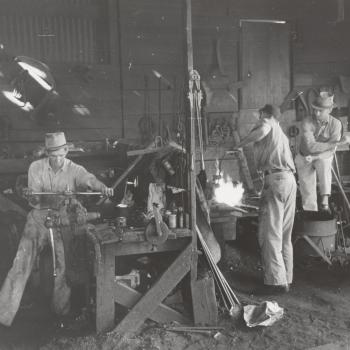Can fashion design be a Christian vocation? No, because isn’t it true that the entire apparel industry is corrupt—from its sweatshops to the manipulative designers to dishonest marketing and sales? And, isn’t it true that fashion contributes nothing to culture or society? And, isn’t it true that there is over-the-top flamboyance in the industry?
Bill Cunningham (1929-2016) pursued his vocation in the real world of fashion. His interest began in grammar school and stayed constant as he thoroughly participated in the industry among its investors, customers, models, buyers, manufacturers, magazines, newspapers, designers, sales force, plus suppliers of material, show directors, party hosts and more.
In a memoir titled Fashion Climbing (Penguin Press, 2018), Cunningham writes about his childhood, his teenage move from Boston to New York City, his jobs in a department store and in advertising, his service during the Korean War, his adventures as a milliner and his early years as a reporter. He stipulated, however, that his story not be published until after his death. The book concludes before his years as photojournalist with New York Times and his popular columns, “Evening Hours” and “On the Street.”
Cunningham reveals that his family did not consider fashion to be a respectable vocation. “My family never came to one of [my] shows until many years later. It took them so long to get over being ashamed of my work, and they never really did accept it,” he writes. “It’s a crime families don’t understand how their children are oriented and point them along their natural way. My poor family was probably scared to death by all these crazy ideas I had, and so they fought my direction every inch of the way,” he continues. “American society has a lot to understand about the natural creative desires of children. Parents should stop feeling ashamed of the arts, and this trend of thinking men who are interested in ballet, opera, and fields of design are just a lot of sissies has caused more unhappy family breakups… Parents [should] accept each child’s God-given personality and stop trying to force what they feel is more suitable for their offspring.”
The book’s title, Fashion Climbing, can be read in two ways. The first sense is social climbing; those elements in the industry that play upon pretentiousness. Cunningham encountered plenty of people who “wanted to use fashion for impressing friends, climbing the social ladder, and everything but sheer enjoyment.” He comments: “The principal reason for me to start my own business was to bring happiness to the world by making women an inspiration to themselves and everyone who saw them. I wanted fashion to be happy… I think it’s about time women stopped all this ridiculous nonsense and wore their clothes for the sheer pleasure that they receive from something beautiful.”
There are con-artist climbers and phonies and chiselers in every walk of life and a serious Christian has to decide over-and-over how to deal with such people. For example, “like with any business, there are small groups of lovely, well-mannered customers who make life worth living,” says Cunningham. “Unfortunately, [some] act like star-spangled bitches, never satisfied, and full of conniving tricks to get the price as low as possible, demanding the best quality and three times more service. One of the snags of high fashion is that it attracts the most ambitious social climbers, show-offs, snobs, bigots and egoists.”
The second sense of climbing in the book’s title is Cunningham’s own ambition. He was not primarily motivated by money. He lived ascetically; sometimes of necessity (sacrificing food to buy fabric) and often of choice (never owning a TV, foregoing movies, riding a bike into his 70s). His ambition was to participate in beauty. He met all of the big names in fashion. He dealt with celebrities. But he was impressed only when he saw a gown or suit or accessories worn in a proper manner. Words like elegant, delightful, thrilling, stunning and beautiful keep this book moving. So too does Cunningham’s genuineness, his frankness and his pranks.
Cunningham had to learn (had to climb to) authenticity. Late in 1955 the New York Times pictured one of his hats next to one created by a master, whose ideas Cunningham admired. Seeing that newspaper photo, Cunningham realized that he was copying. He was mortified. But the incident served to push him up the true ladder. “I was able to free my inner self from outside influence,” he writes. “Ever since that day I have enjoyed happiness in my designing that no hell on earth could destroy. I created the best hats… It’s only when designers make this escape that they can express fully from inside things that they themselves aren’t aware of until they’ve been put into design.”
Near the book’s conclusion, Cunningham makes his way into a fashion show hosted by Cristobal Balenciaga (1895-1972). He was awed by the magnificent garments. “I finally reached the top of the fashion ladder,” he says. “My spirit was renewed… I have seen proof of creative design, and it’s worth every drop of hardship to climb to the top.”
“Elegance is inside a person,” Cunningham concludes. Money in itself cannot buy beauty. Money “often merely allows one to enjoy bad taste with louder vulgarity.”
Cunningham, although known to celebrities and industry titans, was a private person. He especially kept his religious devotion to himself. Hilton Als, in the preface to Fashion Climbing, mentions “a nearly unbearable moment” in a documentary about Cunningham. The interviewer asks “about his faith—his Catholicism. It’s the only time he turns away from the camera, his body folds in on itself.” Yet in a profound way Cunningham’s humble lifestyle attuned him to the beauty which his faith teaches is all around. His was a sacramental imagination. His career was his vocation.
Droel edits INITIATIVES (PO Box 291102, Chicago, IL 60629), a newsletter on faith and work.










